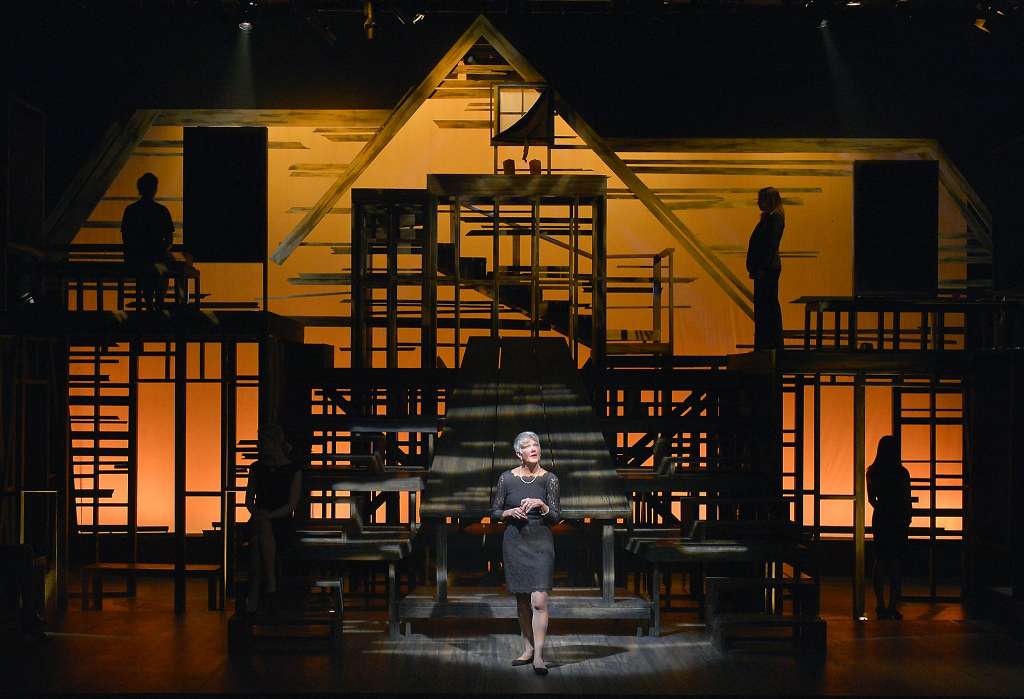Scenery Designed by Professor John Wilson

J.B. Wilson’s set for Marin Theatre Company’s “August: Osage County,” which opened Tuesday, Sept. 13, looks as if it could spring offstage and whack audience members upside the head.
That weapon is just a table, around which three generations of a family eat together, for the first time in years, in the wake of a ghastly shock. But that table, placed at the center of a wooden skeleton of a three-story house, is enormous, angled steeply from a second story down to the stage. (In the show’s big meal scene, actors sit on the steps of two staircases, one on either side of it.) The set piece’s boards widen as they get closer to the audience, creating the illusion that the table is even longer than it actually is, stretching toward a vanishing point skyward, like a bludgeon held in the hand of God.
It doesn’t actually strike the audience, of course, but that table nonetheless fulfills the promise of its expressionistic design, meting out dolorous punishment on the cursed Weston family, and on one member in particular, who later says she “was spoiling for a fight.”
The curse on this rural Oklahoma clan isn’t as explicit as it is in, say, Greek tragedy. The play alludes only vaguely to ancestors’ genocide of Indians, and no god or prophet directly tells the audience that the sins of the parents — addiction, squandered talent, meager love, unfair expectations and an incisive breed of cruelty that homes in on unhealed wounds — must be visited upon the children. But Tracy Letts’ drama carries so much moral heft, paints so full a portrait of the pain that only family members can induce, that its doom feels religiously ordained.
“August: Osage County” caused great fanfare when it premiered in 2007, winning the Pulitzer Prize and the Tony Award for best play the next year. Revisiting it today, Jasson Minadakis, who directs a 13-member cast, makes the case that the play wasn’t just a success of its moment but rather an enduring and unique contribution to the tradition of the American family play.
If “The Glass Menagerie” is a story of the prodigal son leaving home, and in “Buried Child” the prodigal son comes back to a home that’s forgotten him, then “August: Osage County” writes the next chapter. We now live in a world where children, having long departed the family homestead, only visit. Ours is a society, the play attests, that will one day be defined by our failure to care for, to simply be with, our elders as they sicken and near the end of life — not that those elders make it easy, or even possible, to do so.
A defining image in this production is its final one: Violet (Sherman Fracher), the matriarch, having driven out all her relatives by blood and marriage, can seek solace only by weeping in the lap of Johnna (Kathleen Pizzo), the American Indian help her husband, Beverly (Will Marchetti), hired.
Minadakis’ cast is excellent in achieving that rare quality that is the backbone of every great drama: In each conflict, both diametrically opposed sides feel urgently, absolutely in the right. A special commendation goes to Arwen Anderson as Barbara, Violet’s imperious daughter, whose “I’m running things now!” declaration at the close of act two feels both righteous and foreboding of still further hell.
A veteran of Bay Area stages, Anderson often plays roles in which she radiates goodness and openness, so to see her rankle, bloviate and flail with equal command is a true treat, but just one in a production that’s full of them — assuming you can stand how close to home it might hit.
Lily Janiak is The San Francisco Chronicle’s theater critic. Email: ljaniak@sfchronicle.com Twitter: @LilyJaniak